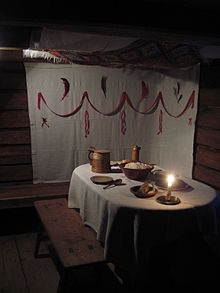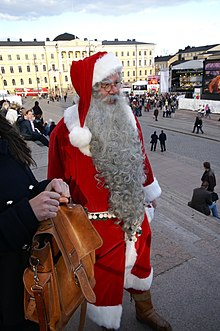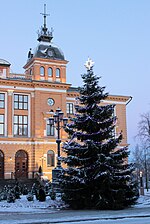
Yule is a winter festival historically observed by the Germanic peoples that was incorporated into Christmas during the Christianisation of the Germanic peoples. In present times adherents of some new religious movements celebrate Yule independently of the Christian festival. Scholars have connected the original celebrations of Yule to the Wild Hunt, the god Odin, and the heathen Anglo-Saxon Mōdraniht. The term Yule and cognates are still used in English and the Scandinavian languages as well as in Finnish and Estonian to describe Christmas and other festivals occurring during the winter holiday season. Furthermore, some present-day Christmas customs and traditions such as the Yule log, Yule goat, Yule boar, Yule singing, and others may have connections to older pagan Yule traditions.

Finnicization is the changing of one's personal names from other languages into Finnish. During the era of National Romanticism in Finland, many people, especially Fennomans, finnicized their previously Swedish family names.
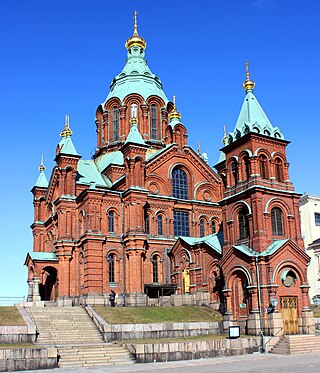
The culture of Finland combines indigenous heritage, as represented for example by the country's national languages Finnish and Swedish, and the sauna, with common Nordic and European cultural aspects. Because of its history and geographic location, Finland has been influenced by the adjacent areas, various Finnic and Baltic peoples as well as the former dominant powers of Sweden and Russia. Finnish culture is built upon the relatively ascetic environmental realities, traditional livelihoods, and heritage of egalitarianism and the traditionally widespread ideal of self-sufficiency.

Saint Knut's Day, or the Feast of Saint Knut, is a traditional festival celebrated in Sweden and Finland on 13 January. It is not celebrated on this date in Denmark despite being named for the Danish prince Canute Lavard, and later also associated with his uncle, Canute the Saint, the patron saint of Denmark. Christmas trees are taken down on tjugondag jul, and the candies and cookies that decorated the tree are eaten. In Sweden, the feast held during this event is called a Knut's party.

Jul or jol is the term used for the Christmas holiday season in Scandinavia and parts of Scotland. Originally, jul was the name of a month in the old Germanic calendar. The concept of jul as a period of time rather than a specific event prevailed in Scandinavia; in modern times, jul is a period of time stretching from the fourth Sunday before Christmas Eve, December 24, to (traditionally) mid-January at the date of Epiphany with the month of December and Christmas, and the week up to the New Year, as its highlight. The modern English yule and yuletide are cognates with this term.

The Yule goat is a Scandinavian and Northern European Yule and Christmas symbol and tradition. Its origin is from Germanic paganism and has existed in many variants during Scandinavian history. Modern representations of the Yule goat are typically made of straw.

Mauno Jokipii was a Finnish professor at the University of Jyväskylä in history specializing in World War II. He was a thorough investigator and a prolific author. Among his works were studies of the local history of Jyväskylä and the university and historical province of Satakunta.
Jyrki Niskanen is an operatic tenor from Finland.

Laskiainen is a celebration with Finnish origins, which includes both pagan and ecclesiastic traditions, and is often described as a "mid-winter sliding festival".

Juha Sihvola was a Finnish philosopher and historian. He was a university professor of general history from 2000, and part of The Academy of Finland's Centre of Excellence program upon Philosophical Psychology, Morality and Politics, serving as the Deputy Director of the Centre of Excellence from 2008. In the years 2004–2009, he was the Director of Helsinki Collegium for Advanced Studies.
Irreligion in Finland: according to Statistics Finland in 2020, 29.4% of the population in Finland were non-religious, or about 1,628,000 people. The Union of Freethinkers of Finland and other organisations have acted as interest organisations, legal protection organisations and cultural organisations for non-religious people. In a 2018 international ISSP survey, 40% of the Finnish population said they did not believe in God, 34% said they believed in God and 26% did not know. Nearly one out of every five people in the country is not a member of a religious organisation, and the number of people with no religious affiliation has doubled in two decades.

Vivica Aina Fanny Bandler was a Finnish-Swedish theatre director and agronomist. She bought a theatre in Helsinki in 1955 and is credited for popularizing avant-garde Finnish theatre. She was also theatre director in Oslo (1967-69) and at the Stockholm City Theatre (1969-1979).

Christmas is celebrated throughout December and traditionally until St. Knut's Day on January 13. The main celebration and the exchange of gifts in many families takes place on Christmas Eve, December 24. The Feast of St. Lucy, a high point in the Swedish Christmas season, is celebrated during Advent, on December 13.
Pikkujoulu is a Finnish traditional party held to anticipate Christmas. The Pikkujoulu party is non-formal, highly festive, and themed after Christmas. Pikkujoulu parties are held by various communities, organisations, companies, or just among friends. Not to be compared with Lilla jul, the latter of which is annually celebrated the Saturday before 1st advent. Lilla jul is celebrated by the Swedish-speaking population of Finland.

Seppo Erkki Sakari Heikinheimo was a Finnish musicologist, music journalist, writer and translator.

Juhani "Jukka" Haavisto was a Finnish musician with the honorary title of music councilor. He also worked as a businessman in advertising business from 1959 to the 1990s, when he retired. However, he is perhaps best known for his work as a songwriter and for having played the vibraphone and the accordion in numerous bands.

Folklore of Finland refers to traditional and folk practices, technologies, beliefs, knowledge, attitudes and habits in Finland. Finnish folk tradition includes in a broad sense all Finnish traditional folk culture. Folklore is not new, commercial or foreign contemporary culture, or the so-called "high culture". In particular, rural traditions have been considered in Finland as folklore.
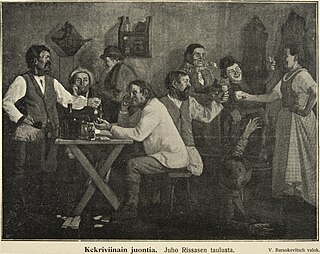
Kekri, also known as keyri, köyri, köyrykööri and kegri, is a Finnish and Karelian harvest festival, celebrated in the fall. Kekri was once widely celebrated in Finland and Karelia, but it has been largely eclipsed by Christmas, to which many old Kekri traditions have migrated. Historically, Kekri has also referred to a deity.

Santa Claus and the Magic Drum is a 51 minute long Finnish-Hungarian animation released in 1996. The story is based on a 1995 children's book of the same name by Mauri Kunnas. The film has been recorded in Finnish, English (British) and Swedish. It was made for TV broadcasting and was first shown on Christmas Eve 1996, and has been broadcast on YLE TV2 nearly every Christmas Eve since. Santa Claus and the Magic Drum has been sold to over 40 countries.
